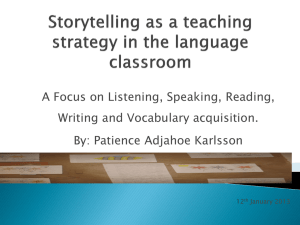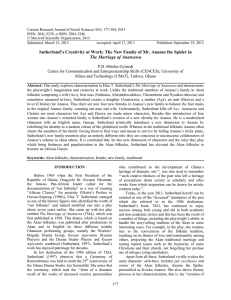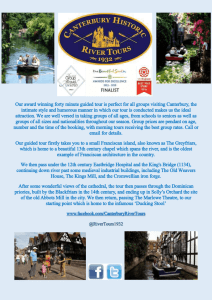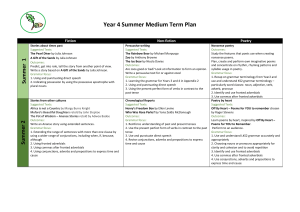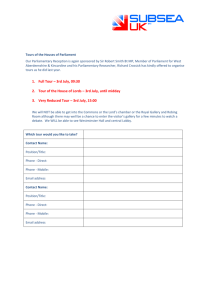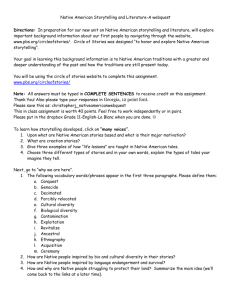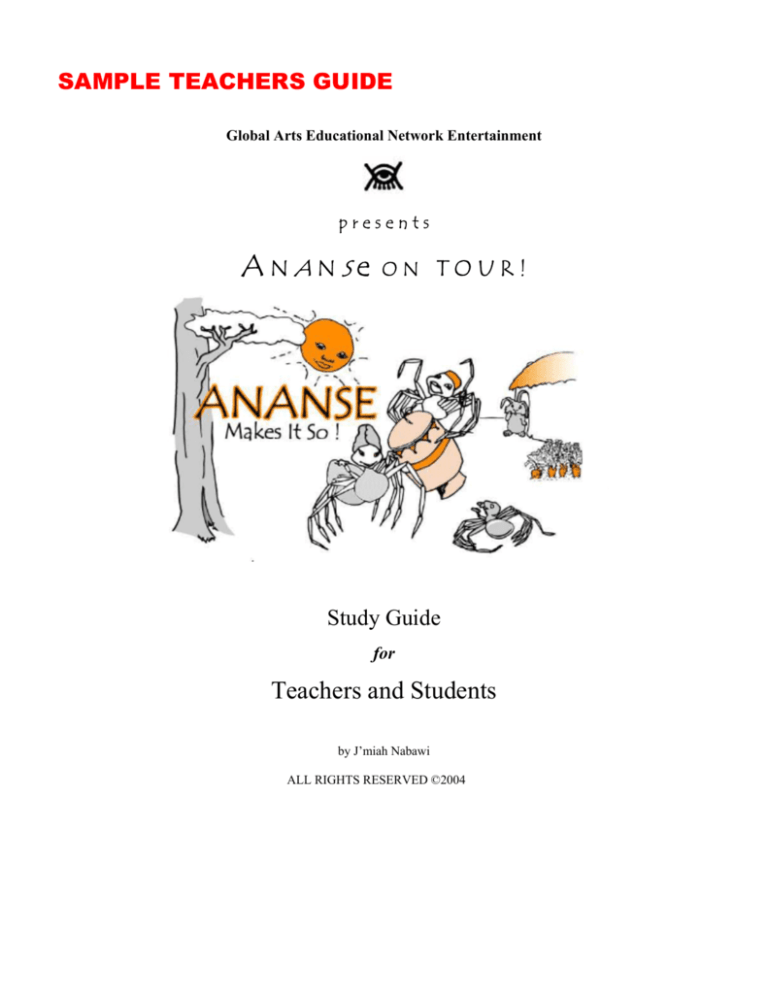
SAMPLE TEACHERS GUIDE
Global Arts Educational Network Entertainment
presents
ANANSe
ON TOUR!
Study Guide
for
Teachers and Students
by J’miah Nabawi
ALL RIGHTS RESERVED ©2004
ANANSE On Tour!
Page 2
BACKGROUND
A n a n s e the S p i d e r
Many of us know about Ananse the Spider through many of the illustrated children’s
books about him and from storytelling festivals and gatherings. However, these very
same stories and storytelling sessions will very rarely mention or include Ananse’s
musical heritage and the numerous recreational folktale songs called mmoguo that are
culturally and historically associated with him. The kente-cloth that has become popular
in the United States and the Caribbean Islands amongst African descendants is a woven
multicolored textile that carry proverbs and wisdom-sayings symbolically woven into its
patterns. Kent- cloth is also culturally connected to and associated with Ananse the
Spider. Ashante legend says that it was Kwaku Ananse who influenced the kente-
cloth weavers in Bonwirie, Ghana centuries ago. It is here with the Akan people,
comprised of many ethnic groups with the Asante being one of the largest, where
Ananse and his fantastic stories, recreational folktale-songs (mmoguo), and the
geometric symbols associated with him have their beginnings.
ANANSE On Tour!
Page 3
Akwaaba
(Welcome)
According to Akan oral tradition, stories and the art of storytelling here on earth is
attributed to Kwaku Ananse. After having successfully completed some very difficult
tasks that were given to him by Otweaduampon Nyame, the original owner of stories,
Ananse the Spider was given all of Otweaduampon Nyame’s stories to bring down to
earth for creatures — man, woman, and child — to enjoy. (See A Story, a Story by Gail
E. Haley; ANANSE Makes It So! by J’miah Nabawi ). As the new owner of all stories and
the first storyteller on earth, anything that had to do with stories and storytelling was
named after Ananse the Spider. This is why we have the word A n a n s e s e m.
Anansesem means the telling of Ananse’s stories, or storytelling in Twi, an Akan
language. Also spelled Anansi (with an “i” on the end), another one of his traditional
names and appellations is Ananse Kokuroko (Ananse the Great Spider). Lastly,
Ananse is married (sorry girls!) and has a family. His wife’s name is Okonore Yaa
(Aso for some). He has four sons whose names are: Intikuma (Elder); Nyaa-Nkoronhwea
(Tiny Legs); Afudohwedohwe (Big Stomach); and Ti-Kenekenen (Big Head). (You may
have read about him having “seven sons” through retold stories about Ananse). In spite
of their odd sounding names and their various physiological shapes and sizes, Ananse’s
sons are very proud of themselves and suffer no lack of positive self-esteem. HAH! From
his origins in Ghana, West Africa, Ananse has traveled the hard way to the so-called
new world. By land and sea and through the oral traditions of the first Africans who came
to the the Americas, the Caribbean Islands, and Europe as enslaved captives. The stories,
some altering Ananse’s name to Aunt Nancy (U.S.), continue to carry the traditional
rhythms, tempos and dance of Ghana and other African nations as they get adapted and
retold to the dictates of their new environs and languages of African derived and Western
cultures of the new world.
ANANSE On Tour!
Page 4
“Ananse is the most popular and frequently encountered trickster and hero in Akan
folktales and stories”1
Before
THE STORYTELLING PROGRAM
Storytelling Does Not Like Idle Talk!
Teachers explain to students that storytelling itself is universal and that life-experiences
and knowledge, family and community traditions and history, customs and values,
1
Dr. Kwasi Aduonum is a leading ethnomusicologist and scholar of Akan culture and folkways.
ANANSE On Tour!
Page 5
acceptable behavior for social conduct and interaction, food customs, (the list goes on!)
are often passed on from one generation to another through storytelling. Ananse tales do
the same, uniquely adding music and dance to the storytelling experience. Ananse tales
(Anansesem) are for both children and adults alike. Everyone is invited to energetically
participate in the storytelling drama through clapping their hands in a variety of rhythmic
patterns, responding with song passages and/or getting up to move and dance.
This makes the storytelling session a unique “communal experience” for everyone, from
toddlers to senior adults, and more fun for everyone besides the storyteller! Read-aloud a
favored Ananse story.
The Anans e stories (and other story gatherings) presented by Mr. Nabawi incorporate
some of the Akan elements of storytelling through the story-dance-musically dramatic
style he has become noted for. The audience is always invited and encouraged to
participate in his upbeat programming. The program and stories are always preceded by
expressive, introductory exclamations and interjections to call everyone’s attention.
Let’s practice one of them.
Teacher says (loudly and expressively):
(pronounced: ah-GO-o-o)
Àgoo?
̀
Students respond (expressively):
Àmee!
̀
(pronounced: ah-MAY)
(repeat)
Translation / Meaning
Leader/Presenter calls:
Àgoo?
̀
Audience responds:
Àmee!
̀
Generally said before a group of people who are gathering and may be chatting about
lightly (or loudly) before the proposed program begins. It is said to quiet everyone down
in order to begin the meeting, class or program that is ready to start.
À g o o ? (Are you with me? Are you awake? Do I have your attention?)
̀
À m e e ! (Yes, we are awake. We are here. You have our attention [and respect].)
̀
ANANSE On Tour!
Page 6
ANANSESEM
KWAKU ANANSE AND THE BIG BIG DRUM
(Adapted from the traditional work of Dr. Kwasi Aduonum)
The story begins with ANANSE who is many, many miles from home. He hears and
falls in love with the rhythmically beautiful sounds of a drum. Upon coming to the place
where the drum is being played, ANANSE offers the craftsman a price for the drum.
The big drum is so heavy that he must carry it home on his shoulders. The children who
live in the villages he passes through have never seen such a big beautiful drum before.
They immediately want to play it. ANANSE refuses to let them play it and while
taking a much needed rest, he is suddenly surrounded by the hundreds of curious children
who get closer and closer to the drum. And then . . . putu-petepete PU-TUM-PAH!
ANANSE is suddenly surrounded by children, laughing and singing while playing his
drum. Ananse soon joins in with the singing and merriment.
ANANSE AND THE HOT BEANS
(A short retelling of a traditional Ananse tale)
ANANSE Makes It So! ( ¡Asi lo hace ANANSE!)
(by J’miah Nabawi)
A bilingual telling (Spanish and English) of ANANSE who gets a visit from his friend
Rabbit. Remembering ANANSE’s fondness for drums and drumming in the old country,
Ghana, Rabbit invites ANANSE to help him make a drum to celebrate their friendship
and to dance and move to some newly discovered latino beats. ANANSE’s refusal to
help Rabbit gets him into an embarrassing predicament that finds him hiding in his web
in the corner of a ceiling.
ANANSE On Tour!
Page 7
Mmoguo!
“. . . storytelling and its accompanying songs represent a family tree-- with roots, stems,
branches and leaves. A story without its mmoguo--songs-- is like a dead tree.”
Dr. Kwasi “Mugafo” Aduonum
The Donno drum
Of special interest to teachers, especially music, dance and physical education / creative
movement teachers, is the word mmoguo. These are recreational songs and games that
accompany Ananse stories-- any story! Mmoguo is folktale-songs as well and can also
function as accompanying preludes and interludes from story to story, to dance to, and
exercise with, to tease, greet, and make salutations. Teachers are also encouraged to use
mmoguo as energizers for the relief of routine staleness and classroom boredom!
The Storyteller will set up and assign the various hand-clapping (nsamu-bo), claves
(nuuamu-bo), double bell (Gankogui), gourd rattle (Axatse) and drum (Donno, Apentema
and Adowa) patterns / rhythms for each part of the mmoguo song interludes. The songs
will also be accompanied with recorded (dubbed) contemporary sound tracks as adapted
(or composed) by Mr. Nabawi.
Gankogui/traditional double bell Students and teachers will be invited to
come up to play hand-held instruments and drums (illustrated) to play along with the
music and to accompany Mr. Nabawi. Please note that schools wishing to have a preevent, in-house experience with mmoguo before the Ananse On Tour! program begins
and would like to arrange to have Mr. Nabawi come out to your school, museum or
preferred place of venue and give a brief introductory presentation on ANANSE On
Tour!, please contact Global Arts Educational Network or the host sponsoring the
ANANSE On Tour! event.
ANANSE On Tour!
Page 8
THE SONGS...
D A N C E and G A M E S
for
A n a n s e On Tour!
KUKYENKU is a song sung by children about
Ananse who did not want the children to play
his big beautiful drum. Children ends up playing
it anyway, with Ananse singing along with
some of the children while others play the drum.
Rhythmic theme and patterns for Kukyenku
kYE-kYE KULE is a traditional song, centuries old, that has become very popular with
music teachers and students in U.S. public schools. The song’s original meaning has been
lost over time. It was traditionally employed as a fun “exercise” game to get children up
from their seated positions to move and stretch. A traditional verse of the song is first
introduced in the story ANANSE Makes It So! The full program version however will be
sung again in its adapted modern version that has today’s children and youth in mind.
Everyone will be invited to “get up to move and stretch” to kYE-kYE’s new beat!
AKAN STONE GAME
aW-bwah see-me sah Nana! This original short story is based on a
traditional Akan stone game. River stones get passed from one partner to the next who
are invited to be teams of “stone-passers.” The accompanying song is sung by the stonepassers and the audience as the stone-passers try not to drop the stones or lose the beat
when the song is sung faster and faster.
With hand-held instruments--Axatse gourd rattle, claves, bells--and drums, the
accompanying music makers chosen from the audience help increase the tempo of the
song. Teachers will select which students will come up when prompted to do so.
ANANSE On Tour!
Page 9
Pεtε Pεtε! is a recreational song about a baby vulture out in the wilderness searching
for food. Its mother has prepared a delicious meal and wants it to come home to eat. It is
sung to discourage children and youth from truany and wandering about wasting their
time. We also use it to call our children to the dinner table when it is time for supper, to
come and eat! The storyteller will conclude the program with this mmoguo, forming a
train-like line-dance of children and adults as they dance off stage and down the aisle to
exit out the door. This shall also be representative of one of the Adinkra symbols found in
the follow-up activites section of the complete Teachers Guide that shows that even in
diversity there are common ground and unity to be found as all living creatures’ need to
eat, be fed. (It is more likely that everyone will be hungry and ready to eat by then
anyway!)
NEW WORDS
AND PHRASES
and all F O L L O W-UP A C T I V I T I E S are in the
“complete” Teachers Guide that will include art-making and creative
writing and drama using ADINKRA (Positive Symbolism).
“Wawa Aba” Adinkra symbol
meaning hardiness and perseverance
At present, the complete guide is only available to schools and agencies
booking Mr. Nabawi’s ANANSE On Tour! showcase as an event or as an “artist-ineducation residency.” ANANSE On Tour! will be featured as ANANSI Tales during
the 2005 Savannah Music Festival’s Educational Youth Concert series
March 23, 2005, 11AM SCAD’s Trustees Theater
.
Gankogui/traditional double bell
J’miah Nabawi Interdisciplinary Storyteller
ANANSE On Tour!
Page 10
Adowa traditional drum
And now you are ready for ANANSE
On Tour!
Come travel with Ananse the Spider through his stories
and fondness of drumming, dance and song . Continuosly boarding in Ghana, West
Africa and making stops in Bahia (Brazil); Santiago de Cuba;
Jamaica and other ports of call and points of interests.
Àgoo?
Àmee!
Axatse gourd rattle
For more information contact
Global Arts Educational
Network
Entertainment
P.O. Box 13946
Savannah, Georgia 31416
912.927.1871
globalartsunited@yahoo.com

